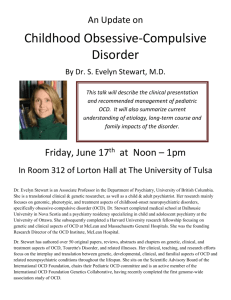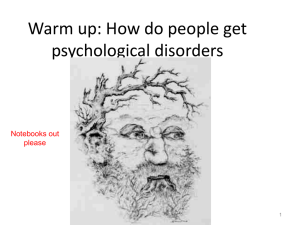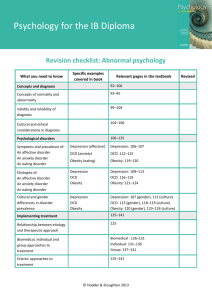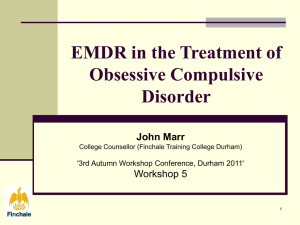summary of glass article
advertisement
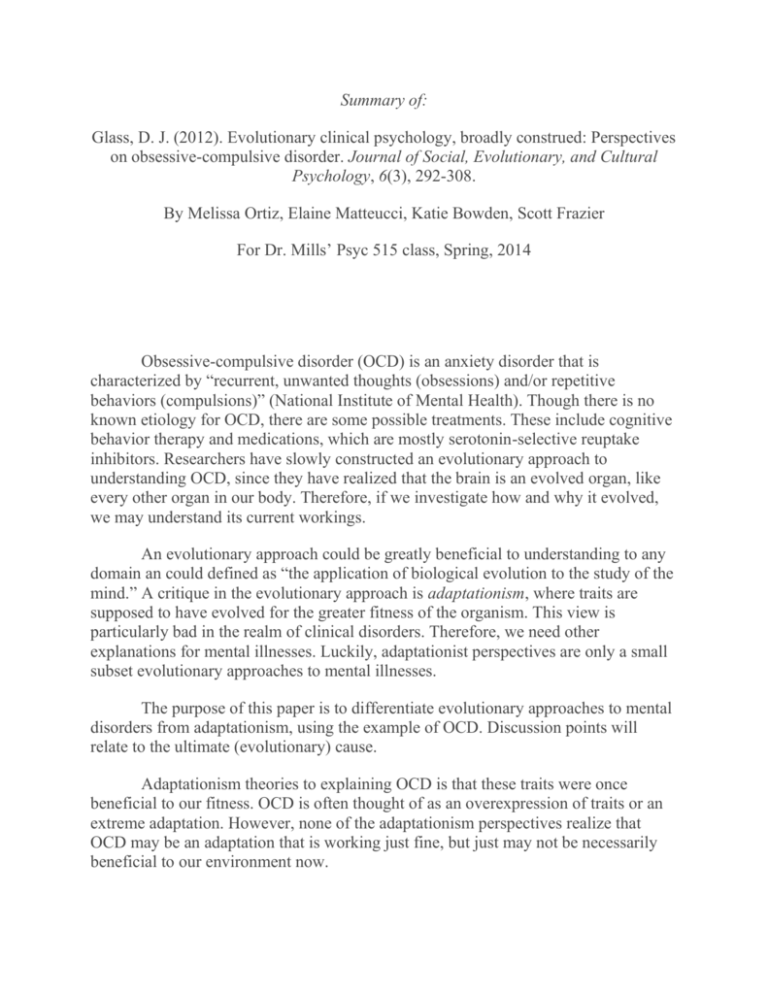
Summary of: Glass, D. J. (2012). Evolutionary clinical psychology, broadly construed: Perspectives on obsessive-compulsive disorder. Journal of Social, Evolutionary, and Cultural Psychology, 6(3), 292-308. By Melissa Ortiz, Elaine Matteucci, Katie Bowden, Scott Frazier For Dr. Mills’ Psyc 515 class, Spring, 2014 Obsessive-compulsive disorder (OCD) is an anxiety disorder that is characterized by “recurrent, unwanted thoughts (obsessions) and/or repetitive behaviors (compulsions)” (National Institute of Mental Health). Though there is no known etiology for OCD, there are some possible treatments. These include cognitive behavior therapy and medications, which are mostly serotonin-selective reuptake inhibitors. Researchers have slowly constructed an evolutionary approach to understanding OCD, since they have realized that the brain is an evolved organ, like every other organ in our body. Therefore, if we investigate how and why it evolved, we may understand its current workings. An evolutionary approach could be greatly beneficial to understanding to any domain an could defined as “the application of biological evolution to the study of the mind.” A critique in the evolutionary approach is adaptationism, where traits are supposed to have evolved for the greater fitness of the organism. This view is particularly bad in the realm of clinical disorders. Therefore, we need other explanations for mental illnesses. Luckily, adaptationist perspectives are only a small subset evolutionary approaches to mental illnesses. The purpose of this paper is to differentiate evolutionary approaches to mental disorders from adaptationism, using the example of OCD. Discussion points will relate to the ultimate (evolutionary) cause. Adaptationism theories to explaining OCD is that these traits were once beneficial to our fitness. OCD is often thought of as an overexpression of traits or an extreme adaptation. However, none of the adaptationism perspectives realize that OCD may be an adaptation that is working just fine, but just may not be necessarily beneficial to our environment now. Abed and de Pauw (1998) claim that our “mental module,” which causes us to think of possible risk scenarios and how to escape them, allows us to think of a priori solutions to problems. OCD is an malfunction of this system. However, this model is seen as incomplete. Others cite that the compulsions of OCD, such as cleaning, may be been beneficial to foraging (Polimeni, Reis, & Sareen, 2005). These authors also suggest that OCD groups benefited from OCD individuals and therefore resulted in a net inclusive fitness for OCD along with pressure to maintain OCD genes at an optimal frequency. These theories rely on the balancing of OCD genes, which can be possible by the heterozygote advantage (individuals who carry two different alleles, which an advantage over those who are homozygous for a particular gene). Antagonistic pleiotropy, in which a gene has both advantageous and disadvantageous effects balance each other out, is another mechanism for balancing genes. This has been proposed to help explain many mental illnesses. Another theory, by Keller and Miller (2006), is based on mutation-selection balance- the fact that mutations can arise in a population “faster than natural selection’s ability to select against them.” Since every individual inherits a relatively small number of mutations from their parents, a combination of these genes could result in certain behaviors that can be classified as a mental illness. Table 1. Possible Evolutionary Forces Accounting for Existence of Mental Disorders Adaptation Trait shaped by natural selection to solve adaptive problems of ancestral environments Mismatch Once-adaptive traits which can be maladaptive or distressing in novel environments Byproduct Trait not directly shaped by natural selection, but which arose as a result of selection on other traits Balancing selection Trait which is harmful in some circumstances but is maintained by natural selection because its benefits offsets its costs in particular environments Mutations Mutations in single or multiple loci results in aberrant functioning; natural selection may be too weak to select against many minor mutations and thus mutations are maintained in gene pool (mutation- selection balance) Lesion/environmental insult Physical damage, environmental stress, or developmental circumstance results in aberrant functioning Evolutionary theorists argue that diagnoses of disorders strictly according to the DSM are too narrow and limiting in their findings. This is due to the fact the criteria listed in the DSM only takes theoretical descriptions of the clinical syndromes into account and lacks an evolutionary approach. Therefore, it lacks additional consideration of how the mind is designed to function and how this can influence the diagnosable disorder as a result. In response, researchers constructed various perspectives/possibilities regarding mental disorders in order to determine whether or not they are being accurately identified as literal disorders in the brain’s ability to function. One evolutionistic possibility proposed for how mental disorders arise is the environmental mismatch theory. This suggests the possibility that a mental or physical disorder came about as a result of the individual being exposed to an environment that was unfamiliar to his/her ancestors. Since his/her ancestors never familiarized with such an environment he/she is not properly equipped for how to handle all the unfamiliar stimuli and components of the environment. For example, advocates of this theory have argued that the modern culture of American society is unnaturally socially structured and therefore can increase individuals’ likeliness in developing ADHD. Wakefield’s concept of harmful dysfunction stems off of this concept is describing how something like ADHD/other “syndromes” would or would not be classified as a disorder. This concept encompasses the idea that a condition should only be considered to truly be a disorder if it is both harmful and a dysfunction. The idea that the condition is harming suggests that it suffices the social values that are considered important in the judgment of the disorder as well as the effects it seems to have on the person’s functioning and impairments. The idea that the condition is dysfunctional relies on scientific analysis of the function. Wakefield’s emphasizes that both these characteristics must be present in order for the condition to be considered as a disorder. This concept has been especially enlightening for theorists regarding OCD. Primarily all have agreed that it would be considered a disorder when related to these criteria because it is both harmful (in that it’s distressing) and dysfunctional (in that there seems to be functional dysregulations represented in the brain). Murphy and Stitch explain these dysregulations occurring in the brain by describing the brain as an evolved system of inter-linked domain specific computation modules. In this sense, the perceive disorders like OCD occurring due to faulty information flow from one module to the other. Since these modules are all interrelated in terms of input and output, a fault at one location between modules can disrupt the whole system. In relation to this interpretation, Glass suggests that there are four dissociable patterns of dysfunction in OCD that are each representative of a specific part of the mental processing that has been affected. Specifically, these four symptoms suggest distinct neural pathways involved in each of the affected domains, which include: washing and cleaning, acquiring physical resources, patterns numbers symmetry and order, and precautions in avoiding danger. These evolutionary theories developed in response to mental disorders demonstrate how evolutionary thinking is grounded in applications broader than just the implications of adaptations. While adaptations are an important element to consider, evolutionary theorists recognize and make use of the influences that also stem from population genetics, mutation-selection balance, ethology, and phylogenetics. The modern evolutionist understands and acknowledges that phenotypes are a result of an interaction of influence from both our genes and the environment and therefore accept taking a holistic approach to analyzing such components. Add Comment Comment Add
